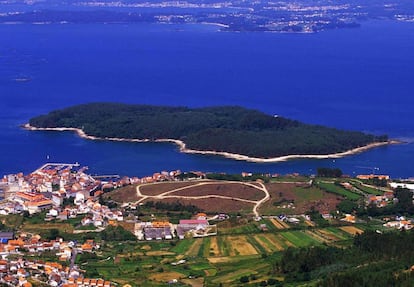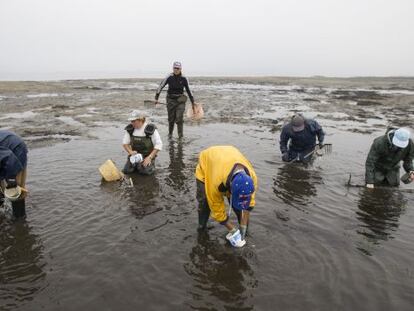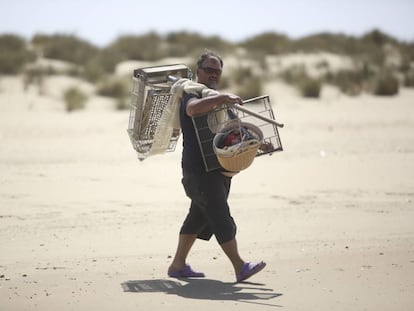Swimming swine stake claim to a Galician desert island
Fishermen complain wild boar are ransacking their produce and coming and going as they please

“They swim like Michael Phelps and their numbers are growing,” says José Luis Villanueva, member of the fisherman’s guild and president of the shellfish farms that farm the cockles and clams that have made Carril, in Vilagarcía de Arousa, Pontevedra, famous. “They come out at night and move in families. There’s one with eight members and another with around 14. And they have a strategy – the strongest keeps a lookout while the others eat. If you want to get close to them at low tide, you have to go against the wind because they have an extraordinary sense of smell.”
The boar have a strategy – the strongest keeps a lookout while the others eat
Villanueva explains that his team of night watchmen – employed to protect the shellfish from poachers, both human and otherwise – spotted the wild boar four years ago and realized they had colonized Cortegada Island, which is separated from the mainland by a sandy channel favored by gourmet-quality bivalves.
Competent swimmers, these wild boar have adapted their nutritional habits to their new environment and root out what they fancy as though aware they are untouchable. For the 54 hectares of flat terrain that makes up Cortegada Island happens to be national parkland that belongs to the National Park of the Atlantic Isles of Galicia and, as such, offers the wild boar protection.

The clam producers have got used to them but still view them as a menace. In 2013, after a mycological association drew attention to the havoc the boar had wrought on the island’s mushrooms – its 600 varieties making this a fungi treasure trove – the shellfish farmers revealed that they were also depleting their “crops.” In an attempt to scare the pigs off, some of the farmers put down plastic nets in the channel and used glass bottles to make a deterring din.
But, some time later, it was discovered that it wasn’t so much the shellfish the boar were after, but the sea worms used by the fishermen as bait.
These wild boar have adapted their nutritional habits to their new environment
According to Villanueva, as they seek out the worms to eat with seaweed and mussels, they destroy everything in their path, making an almighty din in the process. “It’s a riot,” says Villanueva. “They turn the rocks over with their snouts, they roll and splash around, they break shells and generally create merry hell.” They also pull down the walls that separate the banks the shellfish are cultivated on and other walls that have been around since the beginning of the last century.
So why have these pelagic pigs chosen to make their home on Cortegada, an island that was abandoned by its inhabitants to make way for an imposing summer palace for Alfonso XIII in 1910 as a gift from his people?
Perhaps they know they are safe there. For though the island was evacuated, the summer residence was never built. In 1978, the current king’s grandfather, Don Juan de Borbón, sold the archipelago for 60 million pesetas (€360,000); and in 2007 the regional government paid €1.8 million to an estate agent to get it back into the public domain.
It isn’t so much the shellfish the boar are after, but the sea worms used by the fishermen as bait
The shellfish farmers have repeatedly asked Galicia’s regional government and the National Park authorities to remove the wild boar. In June 2014, the Environmental Protection Service caught a man for shooting one of the pigs. Afterwards, a rumor spread that the park authorities were responsible for bringing the first pair of wild boar to the vicinity – the porcine equivalent to Adam and Eve, who then went forth and multiplied. However, the park’s director, José Antonio Fernández Bouzas and his fauna expert Vicente Piorno, deny this vehemently.
According to the director, the first boar swam to the island alone because they are good swimmers and can cover dozens of kilometers in a night. Information gathered by hidden cameras also revealed that there is only one female living on the island along with four adolescents and four piglets. And like the rest of the flora and fauna in the park, they are untouchable. “Some people might not want them there,” says Piorno, “but they came there naturally and they are woodland animals, native to Galicia.”
Fernández adds that the wild boar are themselves are territorial, which helps to keep numbers down. “As far as the mushrooms are concerned, “ he says, “we have got the most specialized of experts in Galicia onto it and they dismiss the idea that the boar are destroying the fungus. They point out that the boars’ rummaging helps the spores to spread. They are part of the pyramid.”
English version by Heather Galloway.
Tu suscripción se está usando en otro dispositivo
¿Quieres añadir otro usuario a tu suscripción?
Si continúas leyendo en este dispositivo, no se podrá leer en el otro.
FlechaTu suscripción se está usando en otro dispositivo y solo puedes acceder a EL PAÍS desde un dispositivo a la vez.
Si quieres compartir tu cuenta, cambia tu suscripción a la modalidad Premium, así podrás añadir otro usuario. Cada uno accederá con su propia cuenta de email, lo que os permitirá personalizar vuestra experiencia en EL PAÍS.
¿Tienes una suscripción de empresa? Accede aquí para contratar más cuentas.
En el caso de no saber quién está usando tu cuenta, te recomendamos cambiar tu contraseña aquí.
Si decides continuar compartiendo tu cuenta, este mensaje se mostrará en tu dispositivo y en el de la otra persona que está usando tu cuenta de forma indefinida, afectando a tu experiencia de lectura. Puedes consultar aquí los términos y condiciones de la suscripción digital.
More information

Why are the shellfish in Galicia’s estuaries dying off?

From illegal fishermen to a Spanish supermarket success story
Últimas noticias
The complicated life of Francesca Albanese: A rising figure in Italy but barred from every bank by Trump’s sanctions
How Japan is trying to avert ‘digital defeat’
Half of Scotland is in the hands of 420 property owners
Reinhard Genzel, Nobel laureate in physics: ‘One-minute videos will never give you the truth’
Most viewed
- Pablo Escobar’s hippos: A serious environmental problem, 40 years on
- Reinhard Genzel, Nobel laureate in physics: ‘One-minute videos will never give you the truth’
- Why we lost the habit of sleeping in two segments and how that changed our sense of time
- Charles Dubouloz, mountaineering star, retires at 36 with a farewell tour inspired by Walter Bonatti
- The Florida Keys tourist paradise is besieged by immigration agents: ‘We’ve never seen anything like this’








































